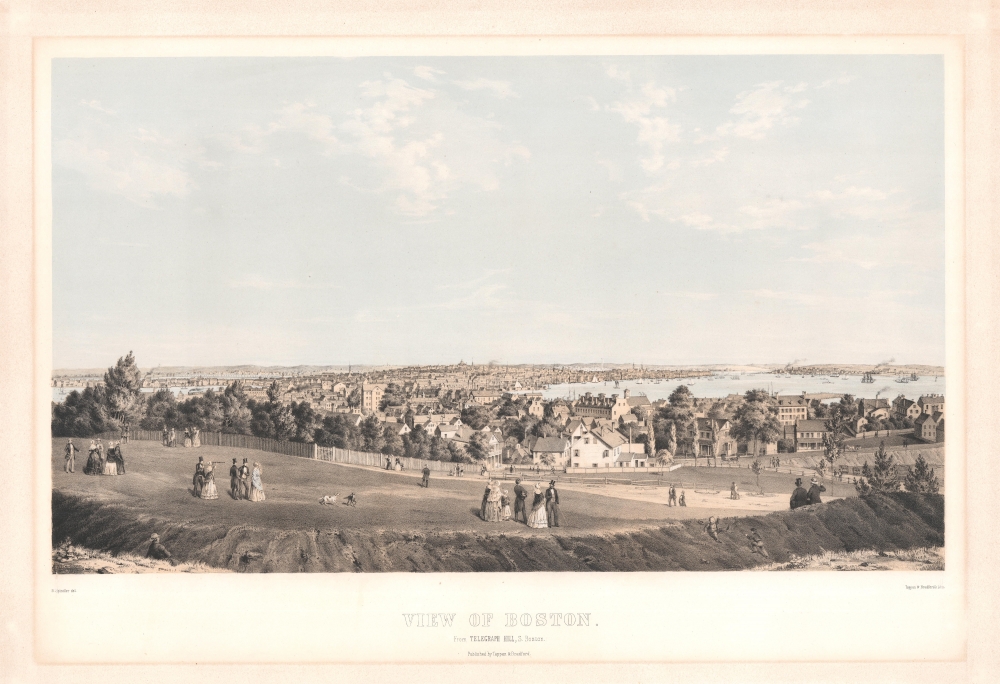1854 Spindler View of Boston, Massachusetts
ViewofBoston-spindler-1854
Title
1854 (undated) 15.25 x 22.5 in (38.735 x 57.15 cm)
Description
A Closer Look
The view looks northwards towards Boston from Telegraph Hill, in modern-day South Boston. In the foreground, elegant citizens promenade over Telegraph Hill. On the left, a young woman with a telescope observes the city. Urban Boston occupies the foreground. As this map predates most major landfill initiatives, the Mill Dam and Boston Neck are visible on the left. Elegant church spires fill the horizon. The curve of Boston Harbor, full of ships of commerce, is illustrated at the center-right. Smoke billows from multiple tall smokestacks, at the time a sign of economic prosperity (as opposed to pollution). South Boston, just in front of Telegraph Hill, is full of well-appointed yet modest New England homes.American Bird's-Eye City Views
The tradition of the bird's-eye city view emerged in the United States in the middle part of the 19th century and coincided with the commercial development of lithographic printing. Before the rise of lithography, the ability to own and display artwork in the home was largely limited to the extremely wealthy. However, lithographic printing made it possible for everyone to own visually striking artwork, and a robust trade developed in portraits of political leaders, allegorical and religious images, and city views.City views were being produced in the United States as early as the 1830s, but the genre exploded after the American Civil War (1861 - 1865). Bridging the gap between maps and pictures, most 19th-century American bird's-eye views presented cities to the public from high vantage points. Some were imagined, but others were drawn from hot-air balloons or nearby hills. The presentation, combining high elevation, commercial interest, and new printing technology, created a uniquely American art form, as described by historian Donald Karshan,
Some print connoisseurs believe that it was only with the advent of the full-blown city-view lithograph that American printmaking reached its first plateau of originality, making a historical contribution to the graphic arts. They cite the differences between the European city-view prints and the expansive American version that reflects a new land and a new attitude toward the land.The vogue for bird's-eye city views lasted from about 1845 to 1920, during which period some 2,400 cities were thus portrayed, some multiple times. Although views were produced in many urban centers, the nexus of view production in the United States was Milwaukee, Wisconsin. The major American viewmakers were Stoner, Wellge, Bailey, Fowler, Hill, Ruger, Koch, Burleigh, Norris, and Morse, among others.
Publication History and Census
This view was drawn by Bernard Spindler and published by Tappen and Bradford in 1854. We note a single example cataloged in OCLC, part of the collection at the Boston Athenaeum. Scarce.CartographerS
Bernard Spindler (December 30, 1825 - December 29, 1865) was a German-American artist and lithographer. Born in Germany, Spindler died one day before his fortieth birthday from consumption. He married Rosalia Stetfilt, another German immigrant, on May 27, 1851. More by this mapmaker...
Ebenezer Tappen (September 11, 1815 - January 25, 1854) was an American engraver, lithographer, and publisher. Born in Manchester, Massachusetts, Tappen began working for a banknote and letterhead engraver in Boston in 1837. He worked as an engraver and lithographer from the same address, 39 State Street, until late 1848 or early 1849, when he formed a partnership with Ludowick Harrington Bradford (November 10, 1820 - December 13, 1885), another engraver and lithographer in Boston. The pair operated Tappen and Bradford until Tappen's death, when Bradford started his own firm called L.H. Bradford and Company. Learn More...
Lodowick Harrington Bradford (November 10, 1820 - December 13, 1885) was a Boston based engraver lithographer active in the second half of the 19th century. Bradford was born in Boston, Massachusetts. He studied as a line engraver before transitioning to the then new art of lithography. He even invented his own photolithographic ambrotype process that created a durable photographic picture on lithographic stone. In 1849 he partnered with Ebenezer Tappen (1815 - 1854) to form the Boston firm of Tappan and Bradford. The partnership remained active until Tappan's untimely death in January, 1854. From 1854 to 1859 Bradford continued to operate the firm, but the imprint changed to 'L. H. Bradford and Company.' It is not clear who the 'and Company' was, possibly Tappan's heirs? From late 1859 until his 1870, he printed under 'L. H. Bradford.' His last known lithographs appeared in 1860, but he did continue copper and steel engraving until his death. Bradford was married to Martha Brown, from an old Gloucester Family. After his wedding in 1849, he divided his time between Gloucester and Boston. In Gloucester he made the acquaintance of the local painter Fitz Henry Lane (1804 - 1865) and worked with him to produce several views in the 1850s. He died on the road between Boston and Gloucester in 1885. Learn More...

